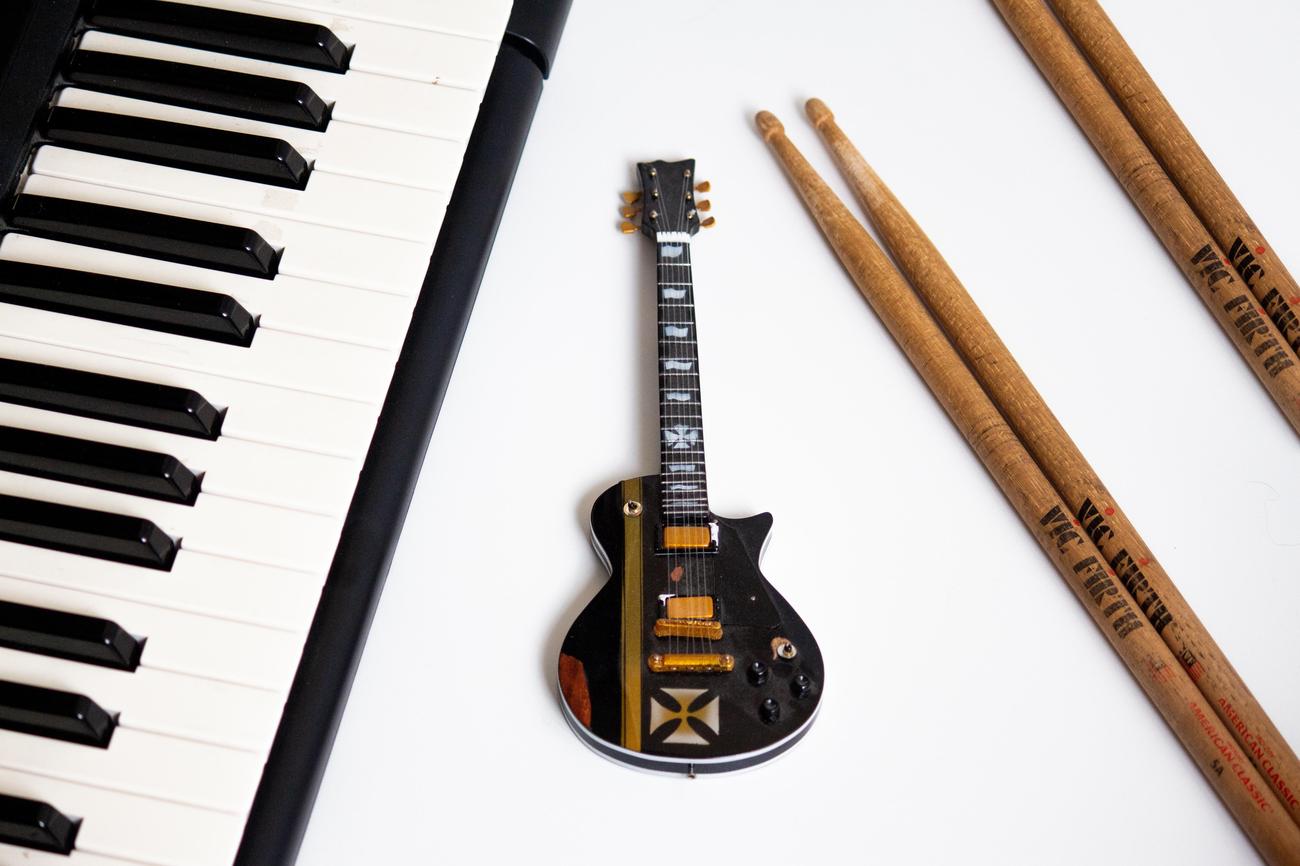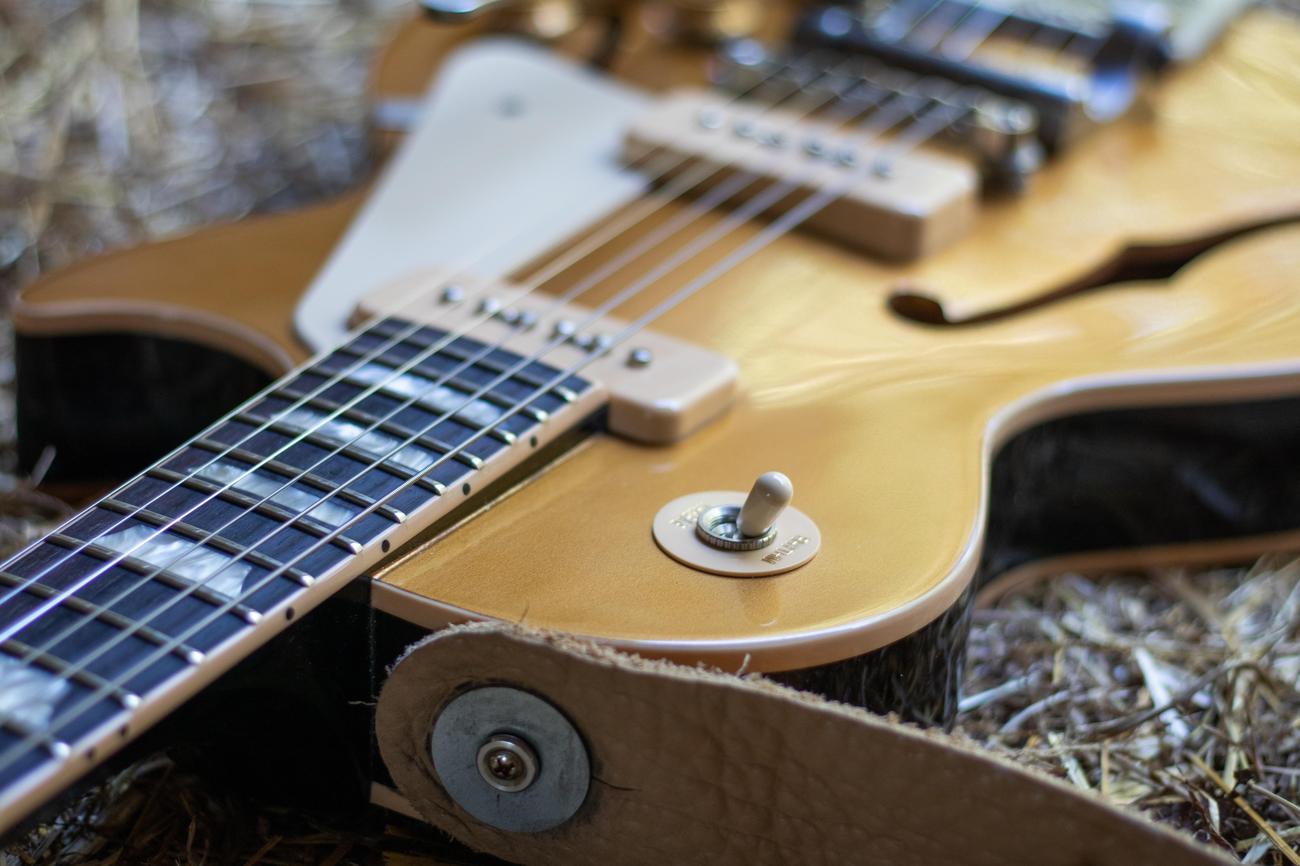Guitars come in different shapes and sizes. Most guitars are made from wood. But there is so much more to these beloved instruments than meets the eye. As a seasoned music enthusiast with over a decade of experience, I am here to unveil the hidden wonders of this iconic instrument. From their intricate construction to the historical context they carry, guitars have a rich and fascinating world that deserves exploration. Join me as we delve into the captivating facts surrounding guitars, revealing their secrets and inspiring a newfound appreciation for their timeless beauty.

Facts About Guitars
Guitars are more than just a simple musical instrument. They hold a rich history and intriguing secrets that merge artistry and engineering. Let’s dive into the captivating world of guitars and uncover some astonishing facts.
The Birth of the Guitar
The guitar has a lineage that dates back centuries. Its origins can be traced to 16th century Spain, where it first took shape. But did you know that ancestral instruments resembling the guitar actually existed as early as 4000 years ago? These early precursors, known as “Tanburs,” were crafted in Persia, modern-day Iran. Their intriguing designs laid the foundation for the modern guitar we know today.
“The guitar’s roots stretch back across centuries, connecting us to the ancient craftsmen who first shaped its captivating form.”
Evolution and Innovation
Throughout history, the guitar has evolved and undergone remarkable transformations. One key player in this evolution was Antonio Torres, who developed the first modern guitar. His pioneering designs, crafted in the 19th century, revolutionized the instrument’s construction and brought forth its iconic shape and sound.
Another major milestone came in the early 1930s with the invention of the electric guitar. This groundbreaking innovation transformed the world of music, paving the way for countless new genres and styles. These electric marvels brought amplification and a new level of sonic possibilities to the fingertips of guitarists.
“The guitar’s evolution has been a journey of ingenuity, pushing boundaries and redefining the limits of musical expression.”
Unleashing Sonic Possibilities
Guitars come in various shapes, sizes, and configurations, each offering unique tonal characteristics and playability. One such innovation that expanded the guitar’s sonic capabilities was the introduction of the 7- and 8-string guitars. Ibanez, a prominent manufacturer, popularized these extended-range instruments, enabling guitarists to explore new frontiers and push the boundaries of their compositions.
“With extended-range guitars, musicians unlock a world of possibilities, where low-end rumble and soaring melodies coexist in perfect harmony.”
Trivia that Strikes a Chord
Guitars also have their fair share of intriguing trivia. Did you know that the word “guitar” finds its origins in an ancient Sanskrit word, “Tar”? This root word spread across different languages, manifesting as “guitar” in English, “Gitarre” in German, and “Guitare” in French. It’s astonishing to see how a word can transcend time and cultures, tying together the global community of guitar enthusiasts.
“Every note we play on the guitar is a testament to the instrument’s rich linguistic tapestry, reminding us of its profound influence across the globe.”
Unveiling the Unseen Wonders
Lastly, let’s explore the often-overlooked world of microscopic guitars. Yes, you read that right! At Cornell University in New York, scientists created the world’s smallest guitar. This minuscule marvel measures a mere 10 micrometers in length, with its strings an astonishing 50 nanometers wide. While this may be more of a scientific feat than a musical instrument, it highlights the guitar’s ability to captivate and amaze beyond our wildest imaginations.
“The world’s smallest guitar serves as a powerful testament to the guitar’s allure, even on scales unseen and unheard before.”
Guitars are not just instruments; they are vessels of history, innovation, and fascination. From its ancient origins to the boundaries it continues to push, the guitar holds a magical allure for musicians and enthusiasts alike. So the next time you strum your favorite chords, take a moment to appreciate the hidden wonders that unfold within the strings and wood of this iconic instrument.
Table:
| Fact | Year/Origin |
|---|---|
| Guitar’s Spanish birth | 16th century Spain |
| Invention of the guitar pick | 1922, D’Andrea USA |
| Ancestral instruments | As old as 4000 years |
| Linguistic connection | English, German, and French derived from ancient Sanskrit word “Tar” |
| Oldest guitars | From Persia, modern-day Iran, 3500 years ago |
| World’s smallest guitar | Created at Cornell University, New York |
| Development of modern guitar | Antonio Torres |
| Invention of the electric guitar | Early 1930s |
| Popularization of 7- and 8-string guitars | Ibanez |
Facts about guitars are always fascinating, and electric guitars have their own enchanting stories. Whether you’re an aspiring musician or simply a lover of music, these interesting tidbits will surely captivate you. Dive into the world of electric guitars and discover the incredible history, innovations, and unique features. Prepare to be amazed!
Did you know that there are more than 40 interesting facts about electric guitars? From their iconic designs to their impact on music genres, each fact unveils a different facet of these awe-inspiring instruments. If you’re ready to expand your knowledge, click here: 40 Interesting Facts About Electric Guitars.
Now, let’s focus on 10 specific facts that will broaden your understanding of electric guitars. These facts cover everything from the first electric guitar’s invention to the different types of pickups used in modern guitars. Are you intrigued? Take a leap into the world of electric guitars and unravel these intriguing facts by clicking here: 10 Facts About Electric Guitars.
Wait, there’s more! For those seeking some fun facts about electric guitars, we’ve got you covered. Get ready to be astounded by mind-blowing trivia that will make you see guitars in a whole new light. Click here to embark on an exciting journey: Fun Facts About Electric Guitars.
Hey, kids! Did you know that learning about guitars can be both educational and fun? Discover amazing guitar facts that are perfect for young music enthusiasts like you. Get ready to have a blast with these fascinating guitar tidbits by clicking here: Guitar Facts For Kids.
The realm of guitars knows no bounds, and we’ve got over 100 facts to prove it! Explore a vast collection of interesting tidbits covering various guitar types, artists, and techniques. Immerse yourself in this treasure trove of guitar knowledge by clicking here: 100 Facts About Guitars.
If you’re more inclined towards acoustic guitars, fret not! We have a list of captivating facts that will make you appreciate the beauty and craftsmanship of these elegant instruments. Dive into the world of acoustic guitars by clicking here: Facts About Acoustic Guitars.
So, what are you waiting for? Click away and embark on an exciting journey through the captivating world of guitars.
Guitars come in different shapes and sizes.
When it comes to guitars, there’s an incredible variety of shapes and sizes that can leave you mesmerized. Whether you’re a beginner just starting out or a seasoned player looking to expand your collection, understanding the intricacies of guitar design will deepen your appreciation for this iconic instrument.
Let’s begin with acoustic guitars, a beloved choice for many musicians. These guitars can be classified into different body types, each contributing to the unique sound and character of the instrument. From the sleek contours of a concert guitar to the broad curves of a jumbo guitar, every shape has its own sonic signature. The size of the guitar body plays a crucial role here.
Imagine the guitar body as a vessel for sound, where the volume of air inside acts as an amplifier. The air capacity varies depending on the size of the body, emphasizing specific frequencies. A smaller body produces a focused sound with an emphasis on higher frequencies, while a larger body brings forth deeper low-end tones. So, when it comes to acoustic guitars, the shape and size of the body play a significant role in shaping the overall sound.
But guitars don’t stop at acoustic variations. Electric guitars, with their powerful presence in rock, blues, and countless other genres, also come in different sizes. However, for electric guitars, the focus shifts from the body to a crucial component: the pickup.
The pickup is like the ear of the electric guitar, transforming the vibrations of the strings into an electric signal that can be amplified. Different pickups can have varying sizes and configurations, influencing the guitar’s tone and response. Single-coil pickups, for instance, have a bright and clear sound, while humbuckers offer a warmer and fuller tone. So, while the overall size of the electric guitar matters, it’s the pickup that has a significant impact on the instrument’s sonic versatility.
Now, let’s dive into the bewildering world of guitar shapes. Guitars come in dozens of variations, and it can be a bit overwhelming to differentiate between them. However, understanding the basic categories can provide a solid foundation for your explorations.
The three main types of guitars are classical guitars, steel-string guitars, and the Hawaiian guitar (often referred to as a lap steel guitar). Each type boasts its own distinctive features and history. With their wider necks and nylon strings, classical guitars are well-suited for fingerpicking and classical music. Steel-string guitars, on the other hand, have a slimmer neck and are the go-to choice for genres like folk, country, and pop. Lastly, the Hawaiian guitar’s unique design and slide technique bring a touch of soulful resonance to the table.
When it comes to sizing, full-size guitars serve as the basis for determining the sizes of smaller models. While the overall length of a guitar can provide some guidance, it’s essential to consider the body sizes and shapes as well. Two guitars might have the same overall length but differ in body proportions, resulting in variations in sound and playability.
So, embrace the wealth of guitar shapes and sizes, and let your curiosity lead the way. Whether you’re drawn to the classic elegance of a concert guitar, the raw power of an electric axe, or the soul-stirring melodies of a lap steel guitar, each style has its own allure. Remember, the shape and size of the guitar contribute to its unique voice and are the gateway to discovering your own expressive potential.
In a world of diverse guitar shapes and sizes, the body design and pickup configuration shape an instrument’s sonic personality. From the focused tones of small bodies to the deep resonances of larger ones, the shape and size influence every strum and pluck. And in the realm of electric guitars, the pickup takes center stage, determining whether your sounds will soar with brightness or resonate with warmth. So, explore this myriad of shapes and sizes, and let your fingers discover the hidden wonders within each one.
Most guitars are made from wood.
Guitars. The mere mention of the word brings to mind images of intricate designs, captivating melodies, and the soulful strumming of strings. But have you ever wondered what gives guitars their unique sound? What makes them so enchanting? One of the key secrets lies in the material from which most guitars are crafted: wood.
Wood, with its innate properties, is the chosen medium for constructing the body of guitars. Its ability to resonate and vibrate in harmony with the strings creates that unmistakable tone and timbre that guitar enthusiasts crave. Picture the wood as a partner to the strings, an essential component in the creation of music.
The body of an acoustic guitar is a symphony of woods carefully selected to achieve the perfect balance. Typically, the bottom of the body is made from a heavier wood, such as mahogany, while the top is crafted from a lighter wood like spruce. This combination allows for a harmonious blend of richness and clarity, adding depth and character to the guitar’s sound. The intricate dance between these carefully chosen woods sets the stage for the beauty that unfolds when the strings are played.
Now, you might be thinking, “What about electric guitars?” While electric guitar bodies may not hold the same significance as their acoustic counterparts, wood is still a popular choice for construction. Electric guitars can be crafted from a variety of woods, each contributing its own unique sonic qualities to the instrument. Maple, mahogany, ash, rosewood, and koa are just a few examples of the diverse woods used.
But why wood? Why has it stood the test of time as the material of choice for guitar construction? Tradition plays a significant role, as guitars have been made from wood for centuries. This long-standing practice carries with it a sense of history and craftsmanship that resonates with players and enthusiasts alike. Additionally, the sound preference of musicians drives the continued use of wood. The acoustic properties of different woods create distinct tones, allowing players to choose the wood that best fits their desired sound.
Wooden guitar construction is also influenced by availability and economics. Wood is widely accessible and offers a range of options to suit different budgets and needs. From the majestic resonance of mahogany to the affordability of basswood, the variety of woods available allows for a broad spectrum of guitars to cater to musicians of all levels.
While alternatives to wood have been explored, they have yet to surpass the status quo. Tradition and player preference weigh heavily in this decision, leading to continued reliance on wood in guitar construction. Wood, with its organic nature and inherent tonal qualities, remains an integral part of the guitar’s captivating allure.
To fully appreciate the fascinating world of guitars, one must delve into the realm of wood. It is through the combination of craftsmanship, historical context, and the innate properties of wood that guitars come alive, captivating our ears and souls. So, the next time you strum those strings or listen to the sweet melodies of a guitar, remember the profound impact that wood has on this iconic instrument.
“Wood, with its innate properties, is the chosen medium for constructing the body of guitars. Its ability to resonate and vibrate in harmony with the strings creates that unmistakable tone and timbre that guitar enthusiasts crave.”
“The intricate dance between these carefully chosen woods sets the stage for the beauty that unfolds when the strings are played.”
“Tradition and player preference weigh heavily in this decision, leading to continued reliance on wood in guitar construction.”
FAQ
Question 1
When were guitars first made?
Answer 1
Guitars were first made in 16th century Spain.
Question 2
What is the significance of the guitar pick?
Answer 2
The guitar pick was invented in 1922 by D’Andrea USA.
Question 3
How old are ancestral instruments of the guitar?
Answer 3
Ancestral instruments of the guitar are as old as 4000 years.
Question 4
What is the origin of the word “guitar”?
Answer 4
The English word “guitar,” the German word “Gitarre,” and the French word “Guitare” were all derived from the same ancient Sanskrit word “Tar.”
Question 5
Where did the oldest guitars come from?
Answer 5
The oldest guitars came from Persia (modern-day Iran) about 3,500 years ago and were called “Tanbur.”
- Unveiling Bernhard Caesar Einstein’s Scientific Achievements: A Legacy in Engineering - July 15, 2025
- Uncover who is Jerry McSorley: CEO, Family Man, Business Success Story - July 15, 2025
- Discover Bernhard Caesar Einstein’s Scientific Contributions: Unveiling a Legacy Beyond Einstein - July 15, 2025















